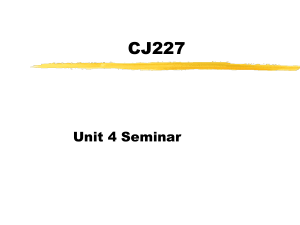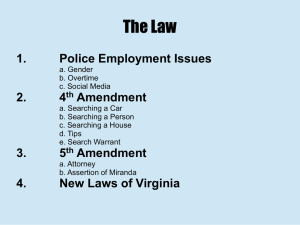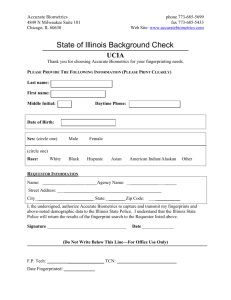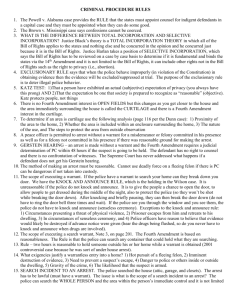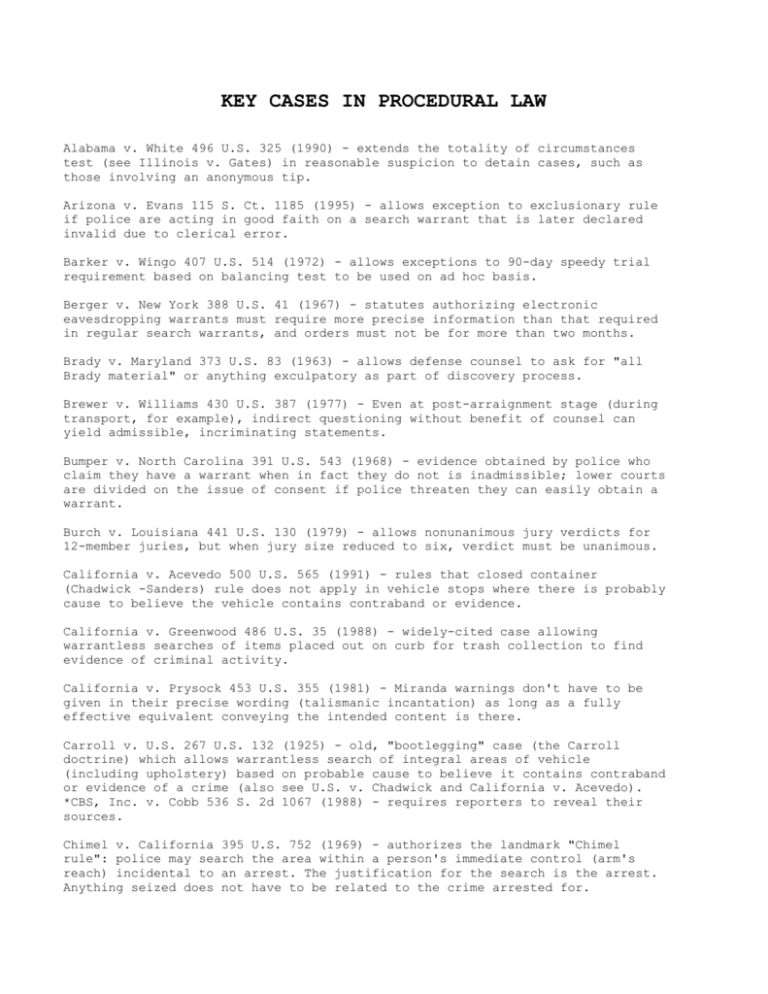
KEY CASES IN PROCEDURAL LAW
Alabama v. White 496 U.S. 325 (1990) - extends the totality of circumstances
test (see Illinois v. Gates) in reasonable suspicion to detain cases, such as
those involving an anonymous tip.
Arizona v. Evans 115 S. Ct. 1185 (1995) - allows exception to exclusionary rule
if police are acting in good faith on a search warrant that is later declared
invalid due to clerical error.
Barker v. Wingo 407 U.S. 514 (1972) - allows exceptions to 90-day speedy trial
requirement based on balancing test to be used on ad hoc basis.
Berger v. New York 388 U.S. 41 (1967) - statutes authorizing electronic
eavesdropping warrants must require more precise information than that required
in regular search warrants, and orders must not be for more than two months.
Brady v. Maryland 373 U.S. 83 (1963) - allows defense counsel to ask for "all
Brady material" or anything exculpatory as part of discovery process.
Brewer v. Williams 430 U.S. 387 (1977) - Even at post-arraignment stage (during
transport, for example), indirect questioning without benefit of counsel can
yield admissible, incriminating statements.
Bumper v. North Carolina 391 U.S. 543 (1968) - evidence obtained by police who
claim they have a warrant when in fact they do not is inadmissible; lower courts
are divided on the issue of consent if police threaten they can easily obtain a
warrant.
Burch v. Louisiana 441 U.S. 130 (1979) - allows nonunanimous jury verdicts for
12-member juries, but when jury size reduced to six, verdict must be unanimous.
California v. Acevedo 500 U.S. 565 (1991) - rules that closed container
(Chadwick -Sanders) rule does not apply in vehicle stops where there is probably
cause to believe the vehicle contains contraband or evidence.
California v. Greenwood 486 U.S. 35 (1988) - widely-cited case allowing
warrantless searches of items placed out on curb for trash collection to find
evidence of criminal activity.
California v. Prysock 453 U.S. 355 (1981) - Miranda warnings don't have to be
given in their precise wording (talismanic incantation) as long as a fully
effective equivalent conveying the intended content is there.
Carroll v. U.S. 267 U.S. 132 (1925) - old, "bootlegging" case (the Carroll
doctrine) which allows warrantless search of integral areas of vehicle
(including upholstery) based on probable cause to believe it contains contraband
or evidence of a crime (also see U.S. v. Chadwick and California v. Acevedo).
*CBS, Inc. v. Cobb 536 S. 2d 1067 (1988) - requires reporters to reveal their
sources.
Chimel v. California 395 U.S. 752 (1969) - authorizes the landmark "Chimel
rule": police may search the area within a person's immediate control (arm's
reach) incidental to an arrest. The justification for the search is the arrest.
Anything seized does not have to be related to the crime arrested for.
Colorado v. Spring 479 U.S. 564 (1987) - interrogations where the defendant
thinks they are being charged with a more minor crime is allowed.
Connecticut v. Barrett 479 U.S. 523 (1987) - an oral confession is admissible
even if the suspect refuses to sign a written statement on advice of their
attorney.
County of Riverside v. McLaughlin 500 U.S. 413 - covers cases where preliminary
hearing and arraignment are combined by state law (causing paperwork delays).
Establishes 48 hour rule interpretation of "promptness" in Gerstein. After that,
burden of delay shifts to the state.
Duckworth v. Eagan 492 U.S. 195 (1989) - the Miranda warnings need not be given
in exact form; regarding the right to an attorney, the phrase "if and when you
go to court" is sufficient. No need that attorneys be producible on call.
Eddings v. Oklahoma 455 U.S. 104 (1982) - no restrictions are allowed on the
number of mitigating factors that defense may introduce for consideration by
judge and/or jury.
Edwards v. Arizona 451 U.S. 477 (1981) - a suspect who invokes their Miranda
rights by demanding an attorney cannot be interrogated further until a lawyer is
made available.
Escobedo v. Illinois 378 U.S. 478 (1964) - for any serious offense, a suspect is
entitled to a lawyer during interrogation at a police station.
Florida v. Riley 488 U.S. 445 (1989) - establishes lower limit of 400 feet for
navigable airspace in allowing aerial surveillance and photography.
Frisbie v. Collins 342 U.S. 519 (1952) - an unlawful arrest does not deprive the
court of jurisdiction to try a criminal case.
Gagnon v. Scarpelli 411 U.S. 778 (1973) - requires two-tier process in probation
revocation hearings (preliminary and final), also benefit of counsel if charges
are contested or substantial reasons defendant needs assistance.
Gernstein v. Pugh 420 U.S. 103 (1975) - Persons arrested without a warrant must
promptly be brought before a neutral magistrate for a judicial determination of
probable cause (preliminary hearing); leaves it to individual states to
integrate prompt PC hearings into pre-trial procedures (see County of Riverside
v. McLaughlin).
Gideon v. Wainwright 372 U.S. 335 (1963) - reverses Betts v. Brady (1942).
Requires a lawyer be appointed for any indigent (poor) person who is charged
with a felony or else person cannot be tried for the felony.
Graham v. Connor 490 U.S. 386 (1989) - use of force case which distinguished
subjective (from perspective of officer at the scene) from objective (hindsight)
standards in tests of reasonableness, allows civil suit claims if objectively
unreasonable.
Hampton v. U.S. 425 U.S. 484 (1976) - there is no entrapment if a police
informant supplies drugs to a suspect who is already predisposed to commit the
crime.
Hoffa v. U.S. 385 U.S. 293 (1966) - also known as the "Test Fleet" case, allows
state to intentionally plant an informant in the suspect's company.
Horton v. California 496 U.S. 128 (1990) - key case involving the "plain view"
doctrine. Warrantless seizure allowed if item(s) in plain view, their
incriminating character immediately apparent, and officer did not violate 4th
Amendment in arriving at place from which evidence could be viewed (inadvertent
discovery).
Illinois v. Allen 397 U.S. 337 (1970) - a disruptive defendant may be removed
from the courtroom and trial may continue without their presence.
Illinois v. Gates 462 U.S. 213 (1983) - the two-pronged (Aguilar) test for
probable cause established in Spinelli v. U.S. (1969) is abandoned in favor of a
"totality of circumstances" test.
Illinois v. Rodriguez 497 U.S. 177 (1990) - searches in which any person having
"apparent authority" over an area gives consent are valid.
Illinois v. Vitale 447 U.S. 410 (1980) - allows exception to double jeopardy
clause of 5th Amendment in conviction on more serious offense if guilty plea
already accepted for a lesser offense, as long as all elements of lesser offense
not included in greater offense.
Jacobson v. U.S. 503 U.S. 540 (1993) - updates the Sherman rule (Sherman v. U.S.
1958) on entrapment; entrapment occurs when agents originate a criminal design,
implant a disposition to commit the act in an innocent person's mind, and then
induce commission of the act in order to prosecute.
Johnson v. Avery 393 U.S. 483 (1969) - Absent other forms of legal assistance,
prisons cannot prohibit "jailhouse lawyers" from assisting other inmates.
Katz v. U.S. 389 U.S. 347 (1967) - established "reasonable expectation of
privacy" test which overturned Olmstead v. U.S. (1928) which restricted
electronic surveillance by trespass rule. Both subjective (person's efforts to
protect their privacy) and objective (privacy right society is willing to
protect) expectations must be considered.
Kirby v. Illinois 406 U.S. 682 (1972) - a person has no right to counsel at
pre-indictment identification procedures (they have not been formally charged
with a crime).
Mapp v. Ohio 367 U.S. 643 (1961) -extends the exclusionary rule established in
Weeks v. U.S. (1914) to state officials, evidence seized illegally is not
admissible.
Maryland v. Buie 494 U.S. 325 (1990) - authorizes a protective "sweep search" in
a person's home during an arrest.
Maryland v. Craig 497 U.S. 836 (1990) - one-way, closed-circuit television may
be used to allow testimony (as in case of child witness) and does not violate
defendant's right to confrontation, as long as other procedural safeguards are
maintained.
Maynard v. Cartwright 486 U.S. 356 (1988) - prohibits vague statutory language
such as "especially heinous, atrocious, or cruel" in capital-murder cases.
Michigan v. Harvey 494 U.S. 344 (1990) - reaffirms "prophylactic rule", that
police-initiated conversations in absence of attorney may only be used to
impeach conflicting testimony and cannot be used in the prosecutions
case-in-chief.
Michigan v. Mosley 423 U.S. 96 (1975) - allows police to initiate another,
sequential interrogation after suspect has invoked the right to remain silent as
long as the right to cut off questioning is scrupulously honored.
Michigan v. Summers 452 U.S. 692 (1981) - police have the right to detain
somebody while a search warrant is being executed.
Michigan State Police v. Sitz 496 U.S. 444 (1990) - police can establish
(sobriety) checkpoints and systematically stop every x number of vehicles
without reasonable suspicion.
Miller v. California 413 U.S. 15 (1973) - created Miller standard (prurient
interest) for obscenity, overturning older standard (without redeeming social
value).
Mincey v. Arizona 437 U.S. 385 (1978) - overturns state-level "murder scene
exceptions" allowing warrantless searches at homicide scenes. Allows limited
"victim or suspect" searches for anything in plain view.
Miranda v. Arizona 384 U.S. 436 (1966) - results of a police interrogation are
not admissible unless suspect is given Miranda warnings and there is a knowing,
intelligent, and voluntary waiver (but see North Carolina v. Butler and other
cases).
Neil v. Biggers 409 U.S. 188 (1972) - established the five factors of eyewitness
reliability (opportunity, attention, accuracy of prior description, certainty,
and length of time); showups do not violate due process if, based on totality of
circumstances, victim is able to make a reliable identification; together with
Manson v. Brathwaite of 1977 established the Biggers-Brathwaite rule which means
that even if police do something to jeopardize fairness or impartiality, a
reliable eyewitness identification would still hold.
New York v. P.J. Video 475 U.S. 868 (1986) - obscenity case consolidating
restrictions on exigency exceptions (Roaden v. Kentucky), requiring pre-trial
adversary hearing (A Quantity of Books v. Kansas), requiring post-seizure
obscenity hearing (Heller v. New York), and supporting affidavits (Lee Art
Theatre v. Virginia).
North Carolina v. Butler 441 U.S. 369 (1979) - waiver of Miranda can be inferred
from suspect's conduct and non-verbal body language.
O'Connor v. Ortega 480 U.S. 709 (1987) - a workplace privacy case establishing
the "reasonableness under all circumstances" test: both inception and scope of
an intrusion must be reasonable.
Oliver v. U.S. 466 U.S. (1984) - trespass case allowing police to enter and
search unoccupied or undeveloped areas outside of a dwelling's "curtilage"
without either a warrant or probable cause.
Patterson v. Illinois 487 U.S. 285 (1988) - a waiver of Miranda constitutes a
waiver of the right to counsel as well as the privilege against
self-incrimination.
Pennsylvania v. Finley 481 U.S. 551 (1987) - defendants have no right to
appointed counsel when seeking post-conviction relief.
Pennsylvania v. Muniz 496 U.S. 582 (1990) - videotape evidence of a suspect,
such as a stop for driving while intoxicated, may be obtained without Miranda
warnings.
Powers v. Ohio 499 U.S. 400 (1991) - peremptory challenges to exclude jurors
cannot be based on race, regardless of race of defendant.
Reno v. American Civil Liberties Union 521 U.S. (1997) - attempts to restrict
exposure of minors to obscene material on the Internet violates the 1st
Amendment.
Rhode Island v. Innis 446 U.S. 291 (1980) - casual conversation between police
officers and suspects constitutes a "dialogue" and requires no Miranda warnings.
Ristanino v. Ross 424 U.S. 589 (1976) - prospective jurors during voir dire may
be questioned regarding their racial prejudices only if facts of case are likely
to inflame pre-existing racial prejudices.
Rochin v. California 342 U.S. 165 (1952) - landmark stomach-pumping case
establishing "balancing test" where rights of individual against shocking and
offensive intrusions are balanced against state's interests in fairly and
accurately determining guilt or innocence.
Schmerber v. California 384 U.S. 757 (1966) - landmark blood-extracting case
which established "threshold requirements" for invasive intrusions versus
state's interests; commonplace medical practices involving no risk, trauma, or
pain can be reasonably expected as part of state's interests.
Sheppard v. Maxwell 384 U.S. 333 (1966) - judge has duty to control case so that
media publicity ("carnival atmosphere") does not interfere with right to fair
trial.
Singer v. U.S. 380 U.S. 24 (1965) - defendants have no right to demand a bench
trial if the prosecutor wants a jury trial; the ability to waive a jury trial is
not of equal importance as the right to demand one.
Spinelli v. U.S. 393 U.S. 110 (1969) - concerns sufficiency of police affidavit
in obtaining a search warrant. Requires informant tip to have veracity and basis
of knowledge; adds reliability (overturned in Illinois v. Gates).
State v. Vejvoda 231 Neb 668 (1989) - judicial notice cannot invade jury's
province of fact- finding.
Stoner v. California 376 U.S. 483 (1964) - a hotel clerk cannot give consent to
search the room of a hotel guest. Hotel guests are no less entitled to
protection than house owners.
Strickland v. Washington 466 U.S. 668 (1984) - presents objective standards for
effective representation by counsel; if undermined adversarial process,
deficiencies were prejudicial, and attorney's conduct fell below prevailing
professional norms.
Tennessee v. Garner 471 U.S. 1 (1985) - amends the old, common law "fleeing
felon" rule. Deadly force cannot be used to prevent the escape of a suspect
unless there is a significant threat of death or injury to the officer or
others.
Terry v. Ohio 392 U.S. 1 (1968) - leading case establishing "stop and frisk"
rule on reasonable suspicion. Police may temporarily detain someone for
questioning if there are specific articulable facts which lead a reasonable
police officer to believe that criminal activity is occurring.
U.S. v. Ash 413 U.S. 300 (1973) - no requirement of an attorney during
post-indictment photographic lineups.
U.S. v. Brignoni-Ponce 422 U.S. 873 (1975) - police cannot stop somebody merely
because of their apparent ethnic ancestry or other single factor profiles.
U.S. v. Chadwick 433 U.S. 1 (1977) - this case, along with Arkansas v. Sanders
442 U.S. 753 (1979), established the Chadwick-Sanders rule which protects the
privacy of closed containers in automobile searches. Overturned by California v.
Acevedo.
U.S. v. Dunnigan 507 U.S. 87 (1993) - defendant's perjury at trial may be
considered as grounds for increasing the sentence even when there has been no
conviction for perjury.
U.S. v. Kelly 14 F3d 1169 (1994) - requires seals on evidence bags, establishes
other procedures for proper chain of custody.
U.S. v. Leon 468 U.S. 897 (1984) - allows exception to exclusionary rule if
police are acting in good faith on a search warrant that is later declared
invalid, due to judicial error.
U.S. v. Martinez-Fuerte 428 U.S. 543 (1976) - Permanent, routine checkpoints for
illegal aliens are allowed without suspicion.
U.S. v. Nelson 419 F2d 1237 (1969) - jury cannot convict on basis of inference
from inference (circumstantial evidence alone).
U.S. v. Sokolow 490 U.S. 1 (1989) - establishes drug courier profiling as
grounds for reasonable suspicion.
U.S. v. Spivey 841 F2d 799 (1988) - right to cross-examine a hostile witness is
not unlimited.
U.S. v. Wade 388 U.S. 218 (1967) - establishes the notion of a "critical"
proceeding where the right to counsel attaches; together with Gilbert v.
California of same year establish Wade-Gilbert rule where suspects cannot be put
into a post-indictment lineup without notification and presence of an attorney.
Vernonia School District v. Acton 515 U.S. (1995) - allows random drug testing
if school has a demonstrated drug problem.
Victor v. Nebraska 114 S. Ct. 1239 (1994) - involves proper instructions to a
jury by a judge.
Warden v. Hayden 387 U.S. 294 (1967) - allows a warrantless search if probable
cause and exigent circumstances are present, a "nexus"; "mere evidence" may be
admitted.
Wilson v. Arkansas 115 S. Ct. 1914 (1995) - allows "no-knock" serving of a
warrant if there are exigent circumstances (danger of violence, escape, or
destruction of evidence). No blanket exception of "knock and announce" rule for
drug cases was established in Richards v. Wisconsin (1997).
Wisconsin v. Mitchell 508 U.S. 47 (1993) - longer sentences for crimes motivated
by racial hatred do not violate the 1st Amendment.
Wong Sun v. U.S. 371 U.S. 471 (1963) - tied "fruit of the poisonous tree"
doctrine in with the exclusionary rule; any action following from an
unconstitutional prior action (primary taint) is also inadmissible.
Zurcher v. Stanford Daily 436 U.S. 547 (1978) - warrants can be issued to search
newspaper premises.
Go to: Key Cases in Evidence Law
Back to Instructor's Home Page
Back to NC Wesleyan College Home Page
Last updated: 10/31/99
Copyright 1998 by author
ALL RIGHTS RESERVED






